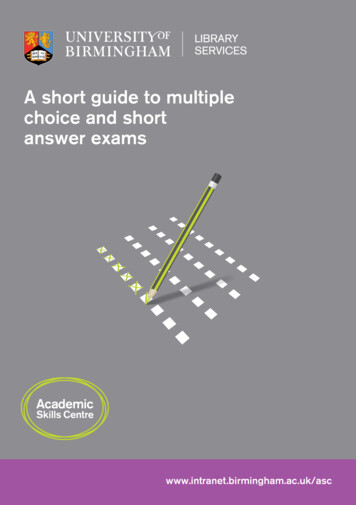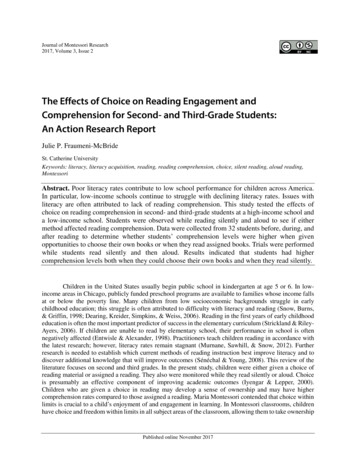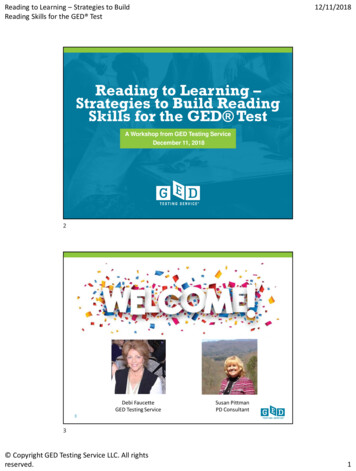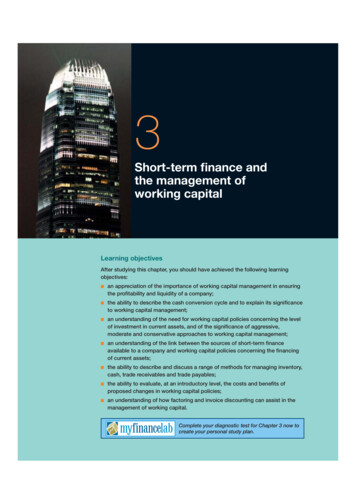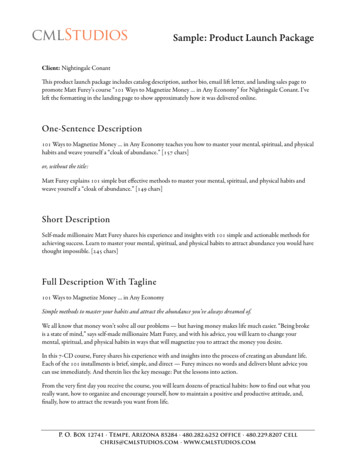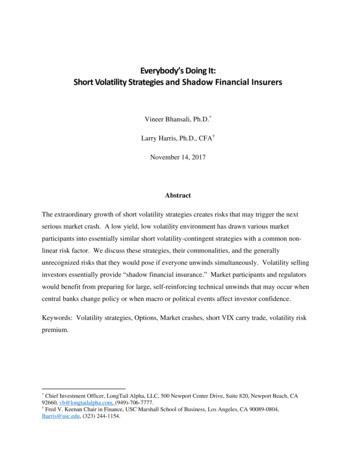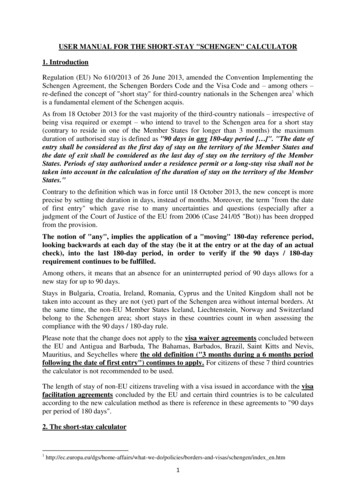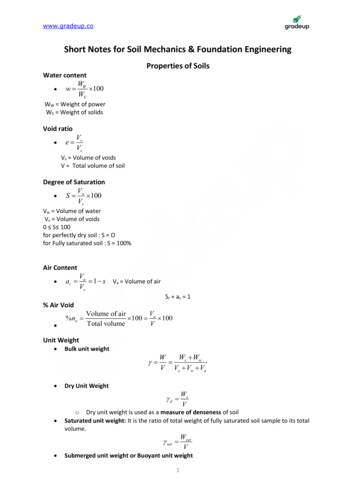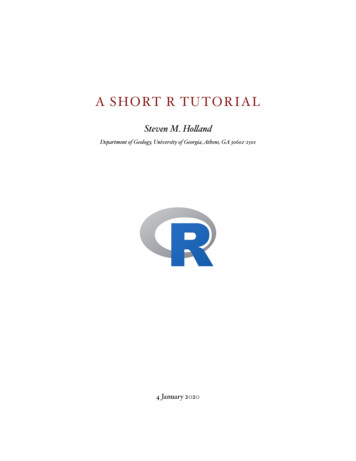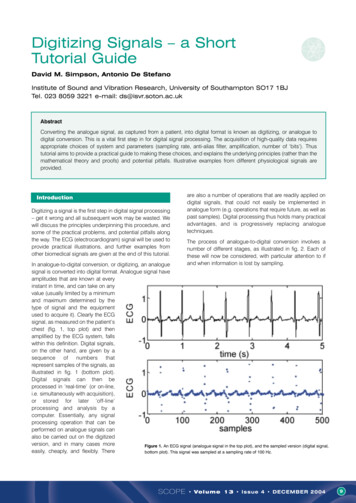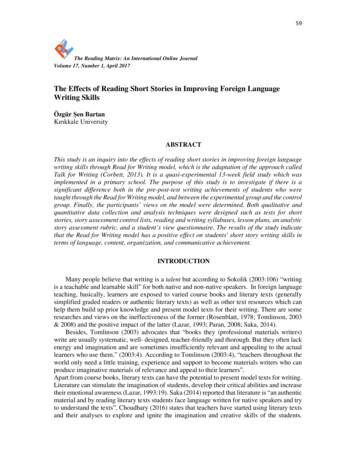
Transcription
59The Reading Matrix: An International Online JournalVolume 17, Number 1, April 2017The Effects of Reading Short Stories in Improving Foreign LanguageWriting SkillsÖzgür Şen BartanKırıkkale UniversityABSTRACTThis study is an inquiry into the effects of reading short stories in improving foreign languagewriting skills through Read for Writing model, which is the adaptation of the approach calledTalk for Writing (Corbett, 2013). It is a quasi-experimental 13-week field study which wasimplemented in a primary school. The purpose of this study is to investigate if there is asignificant difference both in the pre-post-test writing achievements of students who weretaught through the Read for Writing model, and between the experimental group and the controlgroup. Finally, the participants’ views on the model were determined. Both qualitative andquantitative data collection and analysis techniques were designed such as tests for shortstories, story assessment control lists, reading and writing syllabuses, lesson plans, an analyticstory assessment rubric, and a student’s view questionnaire. The results of the study indicatethat the Read for Writing model has a positive effect on students' short story writing skills interms of language, content, organization, and communicative achievement.INTRODUCTIONMany people believe that writing is a talent but according to Sokolik (2003:106) “writingis a teachable and learnable skill” for both native and non-native speakers. In foreign languageteaching, basically, learners are exposed to varied course books and literary texts (generallysimplified graded readers or authentic literary texts) as well as other text resources which canhelp them build up prior knowledge and present model texts for their writing. There are someresearches and views on the ineffectiveness of the former (Rosenblatt, 1978; Tomlinson, 2003& 2008) and the positive impact of the latter (Lazar, 1993; Paran, 2008; Saka, 2014).Besides, Tomlinson (2003) advocates that “books they (professional materials writers)write are usually systematic, well- designed, teacher-friendly and thorough. But they often lackenergy and imagination and are sometimes insufficiently relevant and appealing to the actuallearners who use them.” (2003:4). According to Tomlinson (2003:4), “teachers throughout theworld only need a little training, experience and support to become materials writers who canproduce imaginative materials of relevance and appeal to their learners”.Apart from course books, literary texts can have the potential to present model texts for writing.Literature can stimulate the imagination of students, develop their critical abilities and increasetheir emotional awareness (Lazar, 1993:19). Saka (2014) reported that literature is “an authenticmaterial and by reading literary texts students face language written for native speakers and tryto understand the texts”. Choudhary (2016) states that teachers have started using literary textsand their analyses to explore and ignite the imagination and creative skills of the students.
60Furthermore, Paran (2008) examined the role of literature in foreign language learning andteaching and demonstrated that principled evidence is emerging which is showing the benefitsof using literature. Also, it has been emphasized that more systematic evaluation of courses,and enquiries into the views of the learners were needed. The extent of the use of literature inthe L2 classroom in primary and secondary school settings, the way literature is taught, how itis perceived by teachers and received by students, and how successful it is in promotinglanguage proficiency are some other areas that were suggested by the researcher (Paran, 2008).Additionally, Saka (2008) holds the view that short story has some advantages to teach foreignlanguage compared to other genres. Also, Mourão (2009), listed 30 excellent reasons for usingstories in ELT classrooms under the titles of socio-affective, cognitive, aesthetic, cultural andlinguistic.There are some researches (Can & Sapar, 2010; Çileli & Özen, 2003; Eke, 1997) thatinvestigate the effects of reading in writing performance. For instance, Can and Sapar (2010)examined the effects of reading Little Red Riding Hood and rewriting the story in a creativeway. The researchers reported that students created and developed critical thinking and writingskills and they were highly motivated.Moreover, another study conducted by Çileli and Özen, (2003) investigated the effects ofan extensive short story reading program on the EFL writing skills development ofintermediate-level university students. The study reported that the EFL learners in theexperimental group exposed to the extensive short story reading program attained a higher levelof writing proficiency post-test scores. The findings of this study proposed that the extensiveshort story reading program played a facilitative role in EFL writing proficiency (Çileli & Özen,2003).Besides, Eke (1997) analysed the effects of a short story reading program on the EFLwriting skills development and explored that participants in the experimental group exposed tothe short story reading program showed a significant progress in their writing skills, especiallyin terms of organization and content.This paper presents an investigation into the effects of reading short stories in improvingforeign language writing skills through “Read for Writing” model, which is the adaptation ofthe approach called “Talk for Writing” (Corbett, 2012).Johnston (2008:2) believes that story writing cannot be taught but he is positive that it canbe learned. He claims that everyone knows how to tell stories but“ despite this proficiency, something happens when we endeavour towrite, rather to tell, a story. Somewhere, somehow, we blow it. I think of thisas a breach that opens between the conception of a story, and actualization ofthat story, the distance between the perfect idea in your mind and thefoundering jumble of words on the page. Writing exercises, I believe, serve tointroduce or elucidate techniques and strategies that authors can use to bridgethat void”With regard to the young learners, the techniques and strategies that EFL teachers use topromote writing stories were varied but not systematically planned and evaluated. Manyresearchers argue that reading and writing should be taught together (Grabe, 2001; Hirvela,2004).In this study, Talk for Writing model (Corbett, 2001, 2011, 2012, 2013) was implemented,considering the benefits and appropriateness for the sample group’s age. It was adapted andrenamed as Read for Writing. Therefore, it is essential to examine this model’s and the adaptedversion’s stages profoundly herein.Talk for Writing & Read for Writing
61Corbett and Strong (2011; 2012; 2013) suggest Talk for Writing approach to teach storywriting for primary school learners. It has three main stages: imitation stage, innovation stage,and independent application.The imitation stage starts with a creative context and an engaging start that the foreignlanguage teacher has established to warm up the tune of the text and to help the learnerinternalised the pattern of the language required. The text map of an extract from the story needsto be drawn before the lesson and language teacher shows this map with physical movementsto help the children recall the story. In this way, the children hear the text, say it for themselvesand enjoy it before seeing it written down. Corbett (2012) identifies this stage as follows:“Once they have internalised the language of the text, they are in a position toread the text and start to think about the key ingredients that help to make itwork. This stage could include a range of reading as-a-reader and as-a-writeractivities. Understanding the structure of the text is easy if you use the boxingup technique and then help the children to analyse the features that have helpedto make the text work. In this way the class starts to co-construct a toolkit forthis type of text so that they can talk about the ingredients themselves – a keystage in internalising the toolkit in their heads.” (Corbett, 2012)The innovation stage could begin with activities to warm up the key words and phrases ofthe text focused on. In this stage, all the learners in the classroom plan and write a story together(shared writing). It begins with a boxed-up grid to show how to plan the text and then apply theshared writing step. The learners and the teacher think aloud and decide the best alternatives(words, multi-word units, phrases, sentences, paragraphs etc.) for their story. Corbett (2012)believes that this process enables the learners to develop the ability to generate good words andphrases.“If, during this process a teaching assistant (or in KS2 an able child) flip-chartsup words and phrases suggested, these can be put on the washing linealongside the shared writing so when the children come to write they havemodels and words and phrases to support them. Throughout the sharedwriting, the children should be strengthening the toolkit so they start tounderstand the type of ingredients that may help.”Eventually, the whole class discussion is suggested to observe some good examples ofsuccessful short stories the learners generated.The invention/independent application stage could begin with some activities focused onhelping the children understand aspects that they were having difficulty. Corbett (2012),mentions that this stage,“.will continue to focus on the next steps needed to support progress so thechildren can become independent speakers and writers of this type of text.Perhaps some more examples of the text are compared followed by moreshared writing on a related topic and then the children can have a gothemselves on a related topic of their own choosing.”Corbett (2012) highly recommends that learners’ work should be published or displayed.He believes that it is important to provide children with a purpose for their writing.Corbett’s (2012) Talk for Writing model was adapted for the participants of this study andthe list below shows the steps of the adopted version called Read for Writing:1. Selecting a short story with the help of the Story Selection Control Lists2. Text map activity with repetition and physical movements,3. Read aloud the story,4. Analysing the text in groups (boxed-up planning),5. Vocabulary study: Preparing vocabulary cards in groups for the unknown words andmulti-word units. The card encompasses definition, parts of speech, example(s), pictures, andsynonyms of the words and multi-word units.
626. Presentations on the topics like character description, writing the beginning of a story,to develop the language and style of a story, rhetoric devices etc.7. Writing a text in groups using the topics instructed such as rhetoric devices, goodexamples of sentence patterns, strategies like showing character through what is said and doneetc.8. Shared writing with the whole class,9. Writing a story independently,10. Self-assessment with the rubric,Briefly, each step needs to be implemented by the foreign language teacher so that the storycan be internalised by foreign language learners and the children may have the chance to createtheir own stories independently. Basically, Read for Writing model is not radically differentfrom Talk for Writing approach (Corbett, 2012), but it was expanded by the researcheraccording to the needs of the foreign language learners. The steps such as selecting a short story,reading aloud the story, vocabulary study for foreign language learners, presentations on thetopics like character description, writing the beginning of a story, to develop the language andstyle of a story, rhetoric devices were supplemented with respect to the needs of foreignlanguage learners. Also, it was planned that self-assessment was suitable for the participants,instead of peer assessment. Finally, a personal and class writing log was recommended to jotdown nice expressions, effective and powerful adjectives, adverbs, expressions to be used whiledescribing a character, or any phrase or word that sounds good to the learner. Additionally, theresearcher had a similar writing log to build a bank of nice expressions to be suggested duringthe shared writing sessions.MATERIAL AND METHODSParticipantsThe study followed the quasi- experimental design. Two groups- experimental and controlgroup- were assigned in a private primary school in Ankara, Turkey. The former group was allthe 7th grade students who were voluntarily participated the current program in 2013- 2014academic year, and the latter group was all the 7th graders who took the post test in 2014- 2015academic year. The first one served as an experimental group and the other one as control. Theresearcher administered a pre- post-test to the experimental group and the post- test to thecontrol group to test the effect of using Read for Writing model on developing short storywriting skills. The initial experimental sample group consisted of 54 students of whom 6 didnot complete the entire program due to various reasons (health, absence for a long time). Thetable below demonstrates the details of the participants and the program:Table 1. The participantsExperimentalGroup7th gradeGrade12-13AgeLanguage Level A2 and B1.148 (F: 23, M: 25)NumberProgram Dates 2nd October 201319th February 2014Post Test Dates 19th February 2014Control Group7th grade12-13A2 and B1.131 (F: 15, M: 16)19th February 2015
63MaterialStory Selection Control Lists (SSCL’s), Analytic Story Assessment Rubric (ASAR), readingand writing syllabuses, and lesson plans were designed for this study.It is substantial to explain the steps involved during the development of both SSCL’s andASAR owing to the validity and reliability of the instruments. SSCL’s were designed toevaluate and select authentic short stories for the implementation of the study and ASAR wasto assess the short stories of the participants (pre-test, post-test and self-assessment).1. SSCL’sTwo SSCL’s were developed in three stages:1. Determining the characteristics of appropriate story for the study2. Preparing the drafts of the SSCL,3. Taking the views of the experts on the SSCL,The first control list (SSCL1) checks short stories’ appropriateness for children. LynchBrown and Tomlinson (1999) define children’s literature as “good quality trade books forchildren from birth to adolescence, covering topics of relevance and interest to children of thoseages through prose and poetry, fiction and nonfiction”. This study set out with the aim ofassessing “good quality” of short stories for children. Many researcher (Can, 2012; Civaroğlu,1998; Corbett, 2001; Lukens, 1999; Lynch-Brown& Tomlinson, 1999; Oğuzkan, 2001; Sever,1995; Sever, 2008; Sever, 2013; Sofuoğlu, 1979; Solar, 2012; Tosunoğlu and Alamdar, 2012;Williams, 1990) study on the characteristics of an appropriate story for children and exhibitshared characteristics: Theme, subject, characters, plan, message, environment, and language.The criteria were identified as the common characteristics of an appropriate short story forchildren.The second control list (SSCL2) contains the elements of language/style. Theappropriateness of language of short stories was assessed using language/style checklist. It wasassumed that the objectives that were supposed to be taught in the reading and writing syllabusneeded to be within the stories selected for the implementation. To illustrate, one of the goalsin the programme is to teach participants how to polish their paragraphs with “effective andpowerful adjectives and adverbs (Tired Words List)” (Corbett, 2001). Therefore, it wasconsidered that the texts needed to contain the examples of effective use of adjectives andadverbs. Other linguistic and stylistic features of texts were: Select precise words Try something new Use adjectives & adverbs effectively (adverbs are more powerful) Begin sentences with ed-ing-ly starters, subordinating conjunctions, prepositionalphrases, similes Make the reader picture the scene and experience the emotions Structure statements, questions, exclamations and orders Construct simple, compound, complex and minor sentences Sound effects: the rhythm of the sentences; onomatopoeia, alliteration Use simile, metaphor, personification Move hook to front and jump straight in (Corbett, 2001)Of equal importance, stories need to achieve cohesion. Cohesion is achieved by a numberof devices: conjunctions, substitution, lexical cohesion, ellipsis, (Halliday & Matthiessen, 1976;Özkan, 2004; Uzun, 1995).Short Story SelectionStory Selection Control Lists (SSCL’s), which was designed by the researcher, were usedto select the short stories. It was considered that a wide genre of short stories (detective, science
64fiction, humour etc.) was required, but fairy tale was not included in this group, as Ay & Bartan(2011: 248) observed that it is “the least interesting topic for both genders”.After surveying children’s literature, 20 short stories were distinguished to be elected bythree raters who were experienced English language teachers and had worked in the sameschool with the sample groups for many years. The stories that got the most points were chosento be read during the implementation: A mouthful (89, 3), Just a Pigeon (88, 3), Hairy (88, 3),Umbrella Man (87, 3), The Sound of Annie's Silence (87), Mouse (86, 6), Me and My Cat (86,6).Analytic Story Assessment Rubric (ASAR) consists of three parts: Assessment criteria,criteria definitions, scoring strategies (Popham, 2000; Aslanoğlu & Kutlu, 2003).1.1.Assessment criteriaASAR was developed as an assessment system appropriate for the purposes of evaluatingthe short stories of the participants, including their pre-post-tests and their self- assessmentprocess. It is originally based on the CEFR (2001), Cambridge ESOL FCE rubric and teacher’shandbook (2011), Corbett’s (2008; 2012) Talk for Writing objectives and the writing toolkit(Corbett & Strong, 2011), the researches on reading and writing relations, generating and usingrubrics (Coskun, 2005; Temizkan, 2011; Ülper& Uzun, 2009; Ülper, 2011) and, text linguistics(Uzun, 1995; Williams, 1990) regarding the participants’ foreign language level and age.In conclusion, ASAR contains four main dimensions (criteria) such as language, content,organization, and communicative achievement and 25 descriptors/ sub-skills as listed below:Language:1.Uses the adjectives, adverbs and nouns in the story.2.Uses the precise words and tries something new.3.Begins sentences with “-ed-ing-ly starters”, subordinating conjunctions,prepositional phrases, and similes.4.Makes the reader picture the scene and experience the emotions. Show ratherthan tell.5.Uses statements, questions (?), exclamations (!) and orders.6.Uses simple, compound, complex and minor sentences.7.Reorders sentences.8.Creates special effects by using stylistic devices.9.Uses simple grammatical forms with a good degree of control. (I can understandthe text although there are some grammatical mistakes.)10. Spelling and punctuation are well handled.Content:1.The plot of the story is clear.2.Uses strategies that help with action writing.3Builds up the characters using some strategies. They are believable.4.Creates setting scenes by selecting precise places and time.5.The opening paragraph is really interesting.6.The problem/dilemma is clear in the story.7.Resolution: Ties up the story.8.Ending: There is a reflection on what happened.9.An appropriate title for the story.Organization1.Describes scenes as paragraphs. All parts (beginning - middle - end) areconnected.
652.Uses the linking words correctly both within and across the sentences andparagraphs.3.Uses some cohesive devices correctly.Communicative Achievement1.The story is easy to follow. (I understood every part of the story.)2.Uses past and present tenses in a smooth way.3.The genre and the language of the story fit together.1.2.Criteria definitionsIn ASAR, the participants’ stories were evaluated on a scale of 0-2 (No, Partly, Yes,).It has three dimensions with 0 indicating the work doesn’t meet requirements of the specificcriterion; 1 it has limited problems according to the criterion, and 2 it has almost noproblems. Students' short stories were scored out of 50 as follows: Language 20, Content18, Organization 6, and Communicative Achievement 6.1.3.Scoring strategyAnalytic scoring generates several scores that provide information that is potentially usefulfor guiding instruction and programmatic decisions (Bang, 2013). It’s claimed that examiningseparate aspects of writing allows for a more comprehensive coverage of the construct, thusincreasing the validity of analytic scoring (Charney, 1984; Flower & Hayes, 1981; Quinlan,Higgins, & Wolff, 2009).Briefly, ASAR includes assessment criteria, criteria definitions, scoring strategies(Popham, 2000; Aslanoğlu & Kutlu, 2003), and additionally, it encompasses the descriptors’examples to demonstrate and explain each criterion for not only raters but also the foreignlanguage learners who assess themselves and their peers. It is vital to make the criteria obviousand comprehensible by displaying the sample statements, strategies, devices etc. in ASAR, thus,it was planned to contribute to the reliability of the rubric.Research QuestionsThe focus of this study is to inquire the impact of reading short stories in improving foreignlanguage writing skills, with regard to this, there were three research questions:1. Are there any statistically significant differences between pre-post-test writingachievements of the English language learners who were taught through the writingsyllabus based on Read for Writing model (experimental group)?2. Are there any statistically significant differences between experimental group andcontrol group in terms of short story writing skills?3. What are the experimental group’s views on the model?MethodIt is a quasi-experimental design which uses two separate design groups: The one-grouppre-test-post-test design and post-test-only design with non-equivalent groups (Creswell, 2014).As it hadn’t been ethical1 to conduct a randomized controlled trial in the school in 2013-2014,it was possible and better to assign a control group with all 7th graders in the same school in1The school’s science committee guided the researcher to implement the programme to the whole group of 7thgraders (three groups), as it’s unethical to assign a control group with regard to the equality aspect of thechildren’s rights. That’s why; a control group was assigned in 2014-2015 academic year.
662014-2015 academic year. Therefore, the first design was applied to assess if there was asignificant difference between the pre and post-tests of the experimental group, while thesecond one explored the differences between the post-test scores of the experimental andcontrol group. It’s claimed that “the use of a comparison group helps prevent certain threats tovalidity including the ability to statistically adjust for confounding variables” (Harris, et al.,2006). Briefly, experimental group was pre-tested and post-tested while control group was onlypost-tested.Data Collection and Analysis ProceduresData management and analysis was performed using SPSS 15 and 21. Experimental groupwas received a reading and writing programme based on Read for Writing model. The courseconsisted of 13 weeks and 26 hours of lessons. Each lesson has 40 minutes. Both experimentaland control groups were also exposed to their course books (Spark 3) for 7 hours in a week.Participants in the experimental group were guided to read and analyse authentic shortstories and wrote short stories as explained above (see Talk for Writing and Read for Writing).Briefly, the procedure was: Text map activity with repetition and physical movements, readingaloud the story, analysing the text in groups (boxed-up planning), vocabulary study,presentations on the topics like character description, writing the beginning of a story,developing the language and style of a story, rhetoric devices etc., writing a part of a story ingroups, shared writing with the whole class, writing a story independently, self-assessment withthe rubric, awarding the short story certificates to the ones whose stories were good examplesand discussing the criteria. Participants read three stories (A mouthful, Just a Pigeon, and Meand My Cat) and exposed to the procedure above for each story. Also, three stories (Hairy, TheSound of Annie's Silence, and Mouse) were utilized to be analysed in terms of the style of thetexts by the learners as homework. They wrote five short stories independently, including prepost tests. They had the chance to check their own stories with the help of the ASAR.In contrast, the control group was not assigned reading or writing tasks like the ones inRead for Writing model. They only used their course books (Spark 3) during the academic termwhen they were post-tested.Briefly, both qualitative and quantitative data collection and analysis techniques weredesigned such as pre-post-tests to evaluate short stories, story assessment control lists, readingand writing syllabuses, lesson plans and materials, an analytic story assessment rubric, and astudent’s view questionnaire.In order to establish scoring validity, the pre-post-tests “must be as similar as possible” interms of the tested skills/ sub-skills (Weir, 2005: 250). A couple of sentences were used to servethe beginning of an opening paragraph of a short story as pre-post-tests.The pre-post-tests were scored by three experienced ELT teachers. A native- American andtwo non-native ELT teachers assessed the participants’ short stories (pre-post-tests). Moreover,rater training was essential for rater reliability. Rater training is a “systematic process to trainraters to apply the rating scale and the mark scheme in a consistent way.” (Weir, 2005: 190).For this reason, three ELT teachers were trained through explaining each criterion of the ASARone by one as well as the objectives of the program. Additionally, there needs to be consistencyof marking between raters (inter-rater reliability) (Weir, 2005:34). Three raters’ scores wereanalysed via Intra-class Correlation Coefficient and for pre-test, the correlation was .70 and thepost-test correlation was .80. The scorings of both pre-test and post-tests indicate a good interrater reliability.
67RESULTSIn order to address the first research question - Are there any statistically significantdifferences between pre-post-test writing achievements of the English language learners whowere taught through the writing syllabus based on Read for Writing model (experimentalgroup)?-the statistical package for social sciences (SPSS 15 and 21) were used and analysedvia paired samples t-test to statistically conclude whether or not Read for Writing model hadany impact on short story writing.The data in Table 2 (see Table 2) below show that Read for Writing model had a statisticallysignificant effect (p. 000) on the amount of improvement (Pre-test 16,97; Post-test 26,47,over 50 points) in the experimental participants’ foreign language writing skills.Table 2. The results of paired samples t-test average scores of experimental group’s pre-test andpost-testNMeanStd. fTSig. (2tailed)47-8.57.000p .05As tables 3, 4, 5, and 6 below demonstrate, the amount of progress in the experimentalparticipants’ short story writing skills on language (Pre-test 6,13; Post-test 9,35, over 20points), organization (Pre-test 1,75; Post-test 2,79, over 6 points), content(Pre-test 6,73;Post-test 10,60, over 18 points), and communicative achievement (Pre-test 2,47; Post-test 3,57, over 6 points) is statistically significant.Table 3.Table 4.Table 5.Paired samples t-test average scores of experimental group’s pre-test and post-testresults on est489,354,37DfTSig. (2tailed)477.3.000Paired samples t-test average scores of experimental group’s pre-test and post-testresults on st-test482,791,51DfTSig. (2tailed)475.9.000Paired samples t-test average scores of experimental group’s pre-test and post-testresults on contentNPre-test48Mean6,73Std.DeviationDfTSig. (2tailed)3,97477.02.000
68Post-testTable 6.4810,605,05Paired samples t-test average scores of experimental group’s pre-test and post-testresults on communicative t-test483,571,62DfTSig. (2tailed)476.7.000p .05As mentioned in assessment criteria part above, ASAR contains not only four maindimensions (criteria) such as language, content, organization, and communicative achievement,but also 25 descriptors. These descriptors were analysed statistically before and after theintervention and revealed that all the descriptors’ improvement was statistically significant,except for two descriptors: “Uses statements, questions (?), exclamations (!) and orders.”(p.423); “Resolution: Ties up the story.” (p .055) p .05.The second question was: Are there any statistically significant differences betweenexperimental group and control group?To compare the experimental group’s and control group’s post-tests, the scores wereanalysed through independent samples t-test, and as it is illustrated below (see Table 7) thedifference between the scores of the groups (experimental group 26,47; control group 7,46;p.000) was statistically meaningful.Table 7.The results of the independent samples t-test of the two groups on the post-testGroupNMeanStd. DeviationExperimental4826,4712,8Control317,466Sig. (2tailed)DfT778.8.000p .05Also, results for the experimental and control groups are summarised in Tables 8, 9, 10,and 11 below. The comparison of both groups’ post- test mean values reflects that the amountof improvement in the experimental group’s short story writing sk
the short story reading program showed a significant progress in their writing skills, especially in terms of organization and content. This paper presents an investigation into the effects of reading short stories in improving foreign language writing skills thr
